#aerodynamic winglets
Explore tagged Tumblr posts
Link
TVS Motor Launches Flagship TVS Apache RR 310 with Enhanced Performance TVS Motor Company (TVSM), a leading global automaker in the two- and three-wheeler segment, has launched the all-new TVS Apache
#TVS Apache RR 310#super-premium sports motorcycle#bi-directional quickshifter#aerodynamic winglets#TVS motor#race tuned dynamic stability control#motorcycle customization#2024 TVS Apache#BTO customization#super bike India#Race Tuned Dynamic Stability Control#TPMS#Cruise Control#TVS Motor#Built To Order#Racing Red motorcycle#Bomber Grey Apache RR 310#2024 TVS Apache RR 310#Performance motorcycle India#High-performance motorcycle features#Race Replica motorcycle
0 notes
Text
The Kawasaki Ninja H2R: A Speed Icon Redefining Motorcycling Limits.
Good Old Bandit Good Old Bandit. gob.stayingalive.in Discover the Kawasaki Ninja H2R—a masterpiece of speed and engineering, reaching over 249 mph and setting new performance standards for modern bikes. The Ultimate Speed Machine Motorcycle enthusiasts dream of power, speed, and precision all rolled into one. Few bikes have ever come close to capturing that dream-like the Kawasaki Ninja H2R.…
#249 mph motorcycle#best motorcycles for track racing#fastest production motorcycle#Good Old Bandit#Gud Ol Bandit#high-performance track bikes#high-speed stability motorcycles#Kawasaki H2R engineering marvel#Kawasaki H2R specifications#Kawasaki Ninja H2R#Kawasaki supercharged engine#motorcycle aerodynamic design#motorcycle aerodynamics#motorcycle winglets technology#News#Ninja H2R top speed review#record-breaking superbike#Sanjay K Mohindroo#Sanjay Kumar Mohindroo#Sanjay Mohindroo#superbike forced induction#supercharged motorcycle performance#supercharged superbike#top speed motorcycles 2024#track#track-only motorcycles#world&039;s fastest motorcycle
0 notes
Text
BMW S1000RR Downforce Spoilers/ winglets BMW S1000RR Downforce Spoilers/ winglets. Highly aerodynamic components have been designed to be perfectly integrated into the motorcycle fairing, in an optimal position and inclination to provide more downforce to the front section of the bike. Also enhances style and agression of the motorcycle. Further it improves on stability on braking and strong accelerations.
#BMW S1000RR Downforce Spoilers/ winglets#BMW S1000RR Downforce Spoilers/ winglets. Highly aerodynamic components have been designed to be perfectly integrated into the motorcycle f#in an optimal position and inclination to provide more downforce to the front section of the bike. Also enhances style and agression of the
0 notes
Text
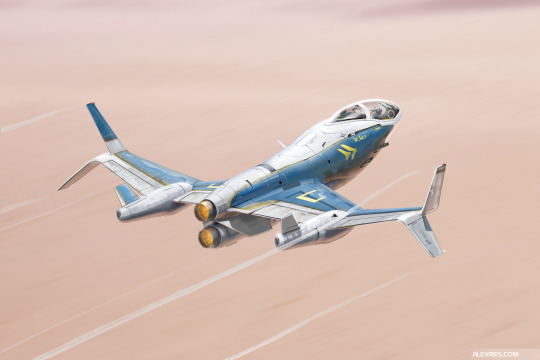
The Tandem Call was a small fighter developed by over-eager birrin engineers as a way to relearn aviation knowledge lost in the Fall. A variety of unconventional control surfaces, including split ailerons and moving winglets, were all tossed into this single airframe to test several aerodynamic concepts. The team never expected that the Tandem Call would ever fire a shot in anger.
In its test bed role weapons, including a powerful cannon, were added. Onboard magazines and under-wing stores could carry a variety of experimental guided and unguided munitions for use on Kiln test ranges. The bubble canopy gave the pilot excellent visibility, but the Tandem Call lacked radar. This shortcoming was partly rectified when the Reclamation wars began with a detachable underwing sensor pod.
During development the team was also only given surplus small jet powerplants: a second turbine was added in ventral pod when the vehicle was found to be underpowered in combat tests, though this could be easily removed for non-combat reconnaissance missions to increase endurance. This pod necessitated the addition of longer landing gear housed in nacelles extending beyond the wing trailing edge.
Despite the idiosyncratic design, the Reclamation wars pulled the Tandem Call into service, its potent cannons felling slower enemy aircraft and strafing ground targets.
Despite its experimental nature, the vehicle was put into serial production to fulfil the need for air power in the explosively escalating conflict, giving rise to a legendary group of pilots who were able to use the idiosyncratic aircraft to great effect against what were increasingly sophisticated adversaries
393 notes
·
View notes
Text
Winglets
Bradley "Rooster" Bradshaw x Reader

Masterlist - Join My Taglist!
Written for Fictober 2024!
Fandom: Top Gun
Day Twenty-Three Prompt: "We can fix this, I know we can."
Summary: Rooster and his SO are housesitting for Penny while she, Mav, and Amelia are on vacation. A relaxing staycation turns into a schoolwork refresher course when they get a little carried away.
Word Count: 1,578
Category: Fluff, Humor, maybe a little bit of Angst?
A/N: Happy Halloween!!
Putting work into an AI program without permission is illegal. You do not have my permission. Do not do it.
"Oh... Bradley."
Bradly hummed, his face buried in my neck and his arms wrapped tight around my waist. I ran my hands through his hair, tipping my head back further to give him better access.
"Are you still upset that Mav left you home?" I teased, running my hands across his shoulders. Bradley huffed a laugh.
"Nah. I'll trade an extended family vacation for this."
I grinned, then let out a little shriek as Bradley wrapped his arms around my thighs and hoisted me up, moving back towards the counter by the wall. My back hit something, hard, and I didn't think much of it until I heard a concerningly loud crash a moment later.
Bradley and I both froze on the spot. Slowly, without moving any more than we had to, Bradley and I pulled back enough to look at each other. His expression of terror exactly matched the feeling in my chest.
The two of us were having a little couples staycation while housesitting for Mav, Penny, and Amelia. The three of them were going on their first ever vacation as a family, and they'd asked Bradley and I to stay over at their place while they were gone. It'd been a nice break from base housing, and we'd been enjoying some uniterrupted alone time. But whatever that crash had been, it didn't sound good.
My eyes didn't leave Bradley's as he glanced over my shoulder. He paled and swore, and that was enough to get me in motion.
I pushed us both away from the counter, then whirled out of Bradley's arms to see how bad it was for myself. My heart dropped.
Amelia's science fair project, which had been sitting on the counter until a few moments ago, now lay shattered on the floor.
"Holy shit," I breathed, just staring in horror for a moment before finally whirling back to Bradley. "Holy shit! What did we just do?"
He shook his head, grave and still way more pale than normal.
"Amelia's going to kill us. And then Mav's going to kill us. And then Penny."
"We're the worst," I said, turning back to the project and shaking my head. My stomach was still down by my feet, a claw of guilt wrapped tight around my chest. "How did we not notice that? Dammit, out of every single countertop in this house, how did we manage to pick this one?"
I heard Bradley take a deep breath from behind me, and then his arm wrapped around my shoulder. I was ready to shake him off—neither of us should be getting comfort right now—but he spoke before I could say as much.
"Alright, this is bad. But it doesn't have to stay that way. We just have to keep a clear head and be smart."
"Baby, I think we're already past the point where being smart could've saved us."
"Not quite."
His hand dropped from around my shoulders, and he moved to crouch next to the broken science project. He picked up a few of the bigger pieces, turning them over in his hands, and then surveyed the poster board that went with it. That, at least, looked mostly still intact.
"We can fix this," he finally said, turning back to me, "I know we can."
"Bradley, it is shattered-"
"It's an airplane aerodynamics project with an arts and crafts execution. I'm a Navy pilot and I've seen you build an F1 car model without the instruction manual. This is exactly our experise."
I closed my eyes and sighed, trying to get a little space from the guilt and panic to think clearly. Bradley was right; the only chance we had to keep this from being a complete and total disaster was to stay calm and be smart. I took a few deep breaths, and when I opened my eyes again, the panic had been mostly replaced by a steely determination.
"Alright. Alright, you make a good point. Let's give it a try."
"Great! Come help me pick up all these pieces, we can set up on the kitchen table. We've still got a day before they get home."
"It took Amelia like two weeks to put this thing together."
"Yeah, but we're not starting from scratch. Come on, positive thoughts."
*****************
The next several hours were chaos. Bradley and I managed to get all the pieces of Amelia's model airplane wings picked up off the floor, but hardly any of it was salvageable. We set everything on the counter, grabbed some pens and paper, and started planning out the best reconstruciton we could get. Luckily, Bradley had to know quite a bit about aerodynamics as a pilot. With the two of us working together and reading off of Amelia's notes, we managed to come up with a plan for putting things back together exactly as they had been.
Putting that plan into motion was where the real chaos came in.
After a quick run to buy supplies, Bradley and I had turned the kitchen counter into a mad scientist's workstation, with bits and pieces of our project laid out everywhere. I worked carefully to put the airplane wings back together while Bradley directed my placement of the arrows and squiggly plastic pieces denoting airflow, pressure, lift, and everything else Amelia needed to cover in her project.
"Okay, those small spirals go on the wing without the winglets."
"Are they seriously called winglets?" I asked, not glancing up from the project in my hands as I worked.
"Yes. Do you want help?"
"Yeah, hold the wing while I take the glue and our little plastic spiral."
Bradley stepped closer, his hands remarkable steady as I went to work. The spirals were supposed to show the air vortices that formed around the wing tip, and how they impacted lift when the little winglets weren't there to slow down their path. The whole time we'd been working on this project, I'd been impressed. Amelia knew a lot, and she'd found some pretty cool ways to show it.
"Alright, just hold that together for a few minutes," I said, leaning away and setting the hot glue gun down once I was done. Bradley did as I said, resting his forearms on the counter and settling in. I surveyed the rest of the countertop. "We're pretty close to done now, aren't we?"
Bradley looked around too, and I could see him going through his own mental checklist. We'd started this little project just after dinner, and now, we were into the early hours of the next morning with no sleep. It was good for both of us to be double-checking each other.
"I think so," he finally said with a nod. "Although we still have to figure out how to replace the couple of things that got messed up on her trifold."
I waved him off. "Easy. All we have to do is retype it on a laptop, print it out, and stick it back where it belongs."
Bradley nodded again, and I put a hand on his shoulder and gave it a gentle squeeze before standing from the kitchen stool.
"I'll go knock it out while you supervise the last of our gluing. We're in the home stretch."
He shot me a tired smile, and I headed to the living room to quickly replace the missing pieces of the trifold. Thankfully, we didn't run into any new complications as we put everything back into its final place. The sun was just starting to come up outside, but when Bradley and I stepped back from the counter, his arm around my shoulders as we admired our work, it looked perfect.
"I can't believe we actually managed to pull that off," I said, huffing a laugh and shaking my head. Bradley squeezed my shoulders, and when I glanced at him, I found him grinning at me.
"I can. We did a great job."
I smiled. "Yeah. Crazy, but we do really make a good team."
He leaned down to place a soft, sweet kiss on my lips. Then, instead of pulling back, he stayed close enough to speak lowly in my ear.
"You know, that was a pretty outstanding parenting move if you ask me. Maybe it's time we-"
"HELL no, Bradshaw," I said, taking a step back with a gentle push on Bradley's chest. "And that's both to having kids right now, and to doing anything more than soft pecks with our hands mostly to ourselves until we get the hell out of this house. We don't have time to fix this whole thing again."
Bradley laughed, pulling me back into his side, and the sound warmed my chest.
"Alright, alright, message recieved. It might be a good idea to wait and see if Amelia notices anything before we celebrate, anyway."
"Welp, we're not gonna have to wait long for that one. Come on, let's go get some sleep before she, Penny, and Mav get home. I'm so tired that if she even glances at me after seeing the project I'll probably crack."
Bradley laughed again as the two of us headed off to the spare bedroom, arms around each other. I'd won the lottery when I'd found him, my perfect wingman in every aspect of life, and I knew he felt the same about me. From science fair projects to beef with coworkers to big life emergencies, there was no one I'd rather have on my side than him.
Even though that love and affection had been the thing to get us in trouble in the first place tonight.
*****************
Everything Taglist: @rosecentury @kmc1989 @space-helen @misshale21
Top Gun Taglist: @elenavampire21
#fictober24#top gun#top gun maverick#bradley rooster bradshaw#bradley bradshaw#top gun fanfiction#top gun x reader#top gun oneshot#top gun imagine#top gun maverick fanfiction#top gun maverick oneshot#top gun maverick x reader#top gun maverick imagine#bradley rooster bradshaw x reader#bradley rooster bradshaw fanfiction#bradley rooster bradshaw oneshot#bradley bradshaw x reader#bradley bradshaw fanfiction#bradley bradshow oneshot#amelia benjamin
78 notes
·
View notes
Text
F101:
F1 Glossary
107% rule
During Q1, any driver who fails to set a lap within 107 percent of the fastest Q1 time will not be allowed to start the race.
However, in some circumstances - which could include a driver setting a suitable time during practice, the stewards may permit the car to start (more often than not the driver is allowed to start)
Appeal
An action that a team takes on its drivers' behalf if it feels that they have been unfairly penalised by the race officials.
The window for asking for a review after an event will be shortened from the current 14 day period to four days, or 96 hours for 2024
Bottoming
When the underside of the car hits the track surface, visually producing sparks. This is usually because of a stiff suspension set up and/or a bumpy track surface
Clean air
Air that isn't turbulent. A car is in ‘clean air’ when it has a gap of at least 5 seconds to the car in front.
Clean air provides the optimum conditions for an F1 car
Degradation (tyre)
The process by which a tyre loses performance or grip, caused by the tyre going through heat cycles (getting warm and cooling down)
Delta time
A term used to describe the time difference between two different laps or two different cars.
Dirty air
Turbulent air that comes off of the back of the car in front. Being in dirty air affects the handling of a car and can cause it to overheat
Downforce
The aerodynamic force that is applied in a downwards direction as a car travels forwards (essentially it is negative lift). This is harnessed to improve a car's handling through corners.
Flat spot
The area of a tyre that is worn heavily on one spot after a moment of extreme braking or in the course of a spin or lock up.
This ruins its handling, often causing severe vibration, and may force a driver to pit for a replacement set of tyres
Ground Effect
A method of inducing downforce by manipulating airflow under the car through the use of winglets and tunnels to create a low pressure area
Handling
The car's responsiveness to driver input and its ability to negotiate corners effectively.
A car that handles well will typically be well-balanced and not understeer or oversteer to any great degree.
LiCo (Lift and Coast)
Something that the race engineer will tell the driver to do if they are burning too much fuel or overheating the car.
It means that the driver will lift off of the throttle early and coast into the braking zone - this slows down their pace so it’s not ideal
Lock-up
The term used to describe a driver braking sharply and 'locking' one or more tyres whilst the others continue rotating. Tyre smoke and flat spots are common side effects.
Marbles
The small pieces of tyre rubber that break off the tyres and then accumulate at the side of the track off the racing line. Typically these are very slippery when driven on.
Out brake
A term used to describe a driver braking either too late or too softly and subsequently overrunning a corner. A common mistake made during overtaking moves.
Oversteer
When a car's rear end doesn't want to go around a corner and tries to overtake the front end as the driver turns in towards the apex. Essentially the rear end of the car moves too much (kicks out) and could cause the car to spin
Parc ferme
A fenced-off area into which cars are driven after qualifying and the race, where no team members are allowed to touch them except under the strict supervision of race stewards.
This is where the post qualifying and post race checks take place.
Cars are under Parc Ferme conditions from the start of qualifying until the start of the race meaning that their set ups can’t be changed during this time.
Plank
A hard permaglass strip (also known as a skid block) that is fitted front-to-back down the middle of the underside of all cars to check that they are not being run too close to the track surface, something that is apparent if the plank is excessively worn.
Porpoising
An aerodynamic phenomenon caused by ground effect where the airflow under the car is suddenly stalled causing a loss of downforce resulting in the car springing upwards. This process continues with the car getting sucked towards the track due to the ground effect, the airflow stalling and then the car springing upwards. This creates a repetitive bouncing, typically on the straights.
The effect can be minimised by raising the ride height
Ride height
The height between the track's surface and the floor of the car.
Scrutineering
The technical checking of cars by the officials to ensure that none are outside the regulations.
Shakedown
A brief test when a team is trying a different car part or a new car for the first time before going back out to drive at 100 percent to set a fast time.
Teams will often run a 100km shakedown at the start of the season before pre season testing
Understeer
Where the front end of the car doesn't want to turn into a corner and slides wide as the driver tries to turn in towards the apex.
Venturi Tunnels
Channels under the floor of the car to funnel and accelerate airflow
The channels have a specific hourglass shape, wide opening and exit with a narrow centre section.
This creates a low pressure zone which will accelerate the airflow and induce downforce
225 notes
·
View notes
Text

Top Super Bikes
These motorcycles represent some of the most advanced and high-performance superbikes in the world, designed for speed, precision, and cutting-edge technology. Here's an overview:
1. Yamaha YZF-R1M:
An elite version of the Yamaha R1, the YZF-R1M is a track-focused superbike featuring advanced electronics, Öhlins semi-active suspension, and lightweight carbon fiber bodywork. Its cross-plane crankshaft engine delivers exceptional torque and a unique sound.
2. Ducati Panigale V4 R:
A masterpiece of Italian engineering, the V4 R is Ducati's homologation special for racing. It features a 998cc Desmosedici Stradale R engine, winglets for aerodynamic stability, and top-tier electronics like traction control and wheelie control.
3. Honda CBR1000RR-R Fireblade:
Honda's flagship superbike, this model emphasizes precision and control. Equipped with a high-revving inline-four engine and advanced aerodynamics, it's a favorite among racers and enthusiasts.
4. Suzuki GSX-R1000R:
The GSX-R1000R is Suzuki’s pinnacle sportbike, combining the brand's legendary "Gixxer" heritage with modern tech like a bi-directional quick shifter, ride modes, and adjustable suspension.
5. BMW S1000RR:
Known for its shark-like design and power, the S1000RR boasts a ShiftCam engine for variable valve timing, integrated electronics, and razor-sharp handling.
6. Kawasaki Ninja ZX-10RR:
A race-homologated version of the ZX-10R, the ZX-10RR has a lightweight design, forged pistons, and a screaming inline-four engine tuned for racetrack domination.
7. Aprilia RSV4 1100 Factory:
This Italian superbike blends a 1078cc V4 engine with MotoGP-derived aerodynamics and semi-active suspension, delivering exceptional agility and power.
8. Kawasaki Ninja H2 Carbon:
A street-legal supercharged beast, the H2 Carbon combines jaw-dropping power with carbon-fiber bodywork and advanced electronics, setting it apart as an engineering marvel.
#bikes#electric bikes#motorcycle#triumph#moto#kawasaki#yamaha#ducati#suzuki#bmw#bmw motorsport#superbikes#automobile#automotive
10 notes
·
View notes
Text
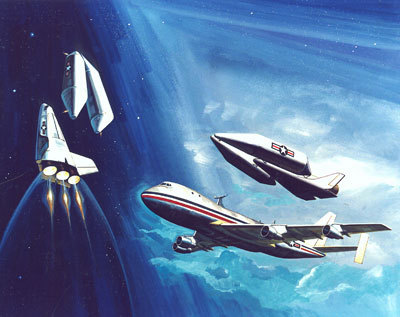
"Rockwell concept for an air-launched spaceplane produced as part of the Advanced Military Spaceflight Capability study."
"In December 1980, Don Hart of the Air Force Rocket Propulsion Laboratory at Edwards Air Force Base wrote a memo describing a proposed Air Force Space Sortie Vehicle that would be launched from the back of a 747. Ehrlich says that he knew Hart at the time, and that it is possible that Hart got the idea of the Space Sortie Vehicle concept from some work that Rockwell was then engaged in. “I’m not sure which came first, Don’s or ours, or they may even have been shared concepts,” Ehrlich remembers. He said that around 1978 or ’79 the Air Force was interested in a concept that they then called 'On-Demand Launch.' Rockwell learned of the Air Force interest and began working on several concepts. In 1979, the Air Force initiated an Advanced Military Spaceflight Capability Technology Identification Study (known as AMSC) and Rockwell was ready for it. The AMSC study actually preceded and ran concurrently with the Air Force Space Sortie Vehicle outlined in Hart’s December 1980 memo.
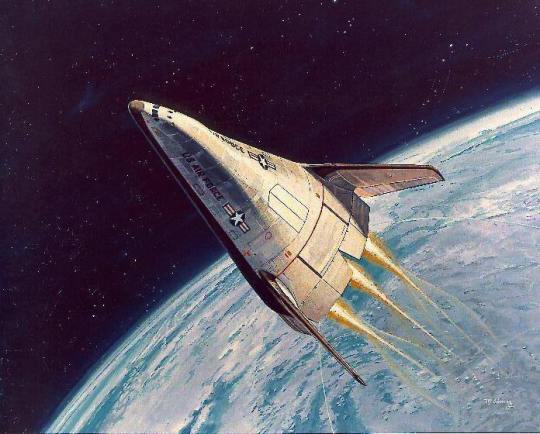
Ehrlich had taken his lifting body knowledge with him to Rockwell. The FDL-5A shape seen pulled out of the C-5 in the artist impression is the more angular version, with the single tail. But when Rockwell started working on the AMSC, they considered a spacecraft with drop tanks and mounted above a 747. The shape they used in that study was the more rounded version, with winglets. 'Different mission, different shape, but retaining the critical aerodynamic features which were key,' Ehrlich explained. The craft could be wider because it did not have to fit inside an aircraft. The Rockwell craft also had three rocket engines in its tail.
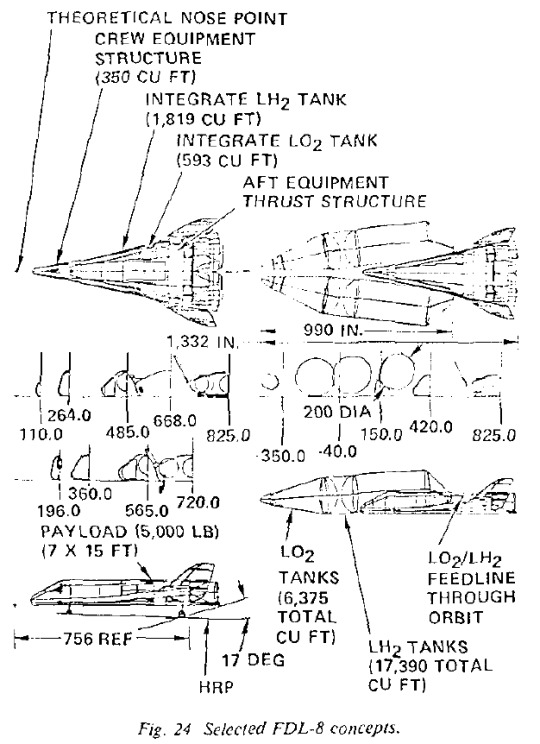

The Rockwell approach was to use the V-shaped drop tank only for hydrogen. The spacecraft itself would carry both oxygen and a little bit of hydrogen for the final push into orbit. This simplified the tank design, and since the tank was the expendable part of the spacecraft that reduced cost.
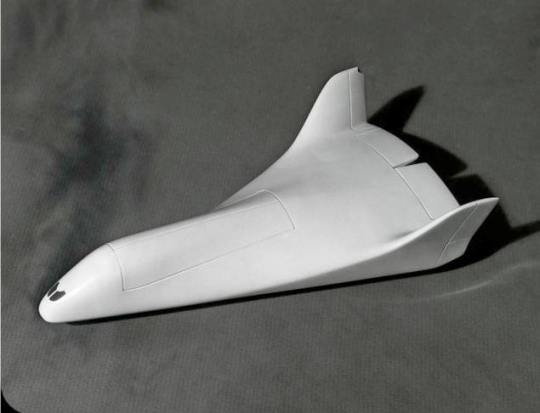
But Rockwell ran into the same limitations experienced by other companies that looked into the Sortie Vehicle Concept. Such a craft could only carry a relatively small payload. But it also required drop tanks, and that increased the expense. The Air Force wanted a cheaper vehicle and the only way to achieve that would be to develop one that was fully reusable."
Date: late 1970s/early 1980s
source
#FDL-5A#FDL-8A#Advanced Military Spaceflight Capability study#Space Sortie Vehicle#Boeing 747#747#carrier#cancelled#concept art#1970s#1980s
32 notes
·
View notes
Text
Condor-inspired retrofit boosts wind turbine energy production by 10%
18 notes
·
View notes
Photo
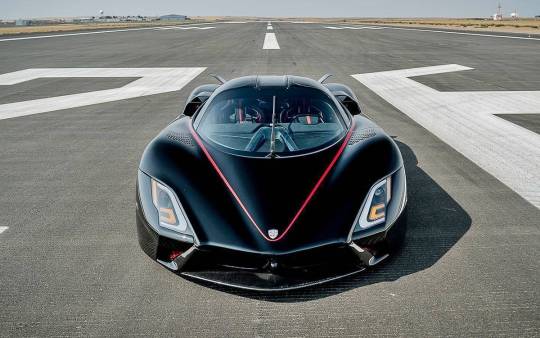


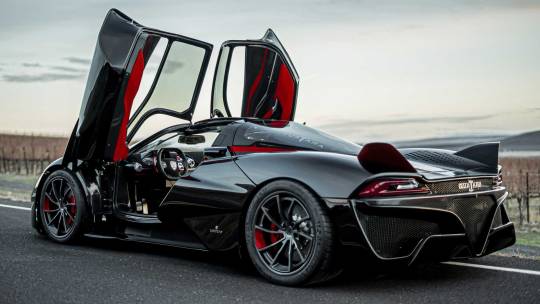
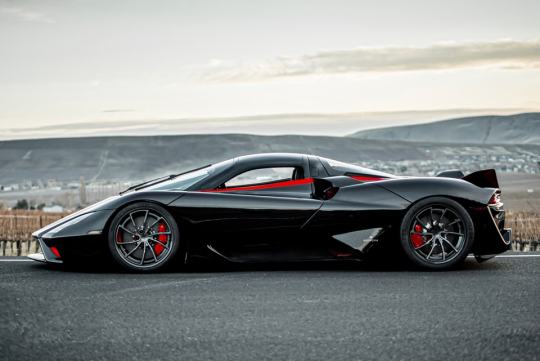

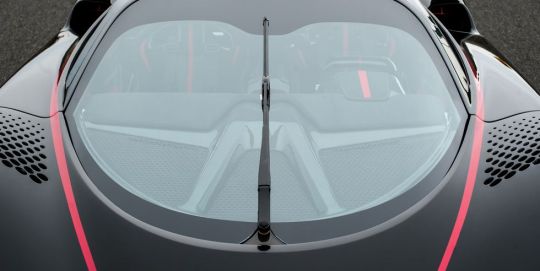
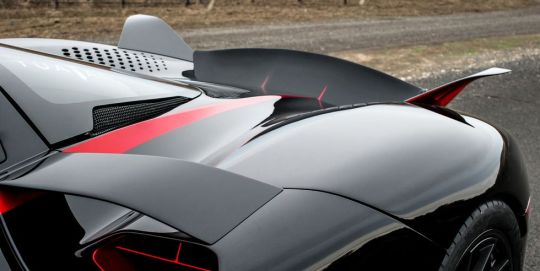


SSC Tuatara (1 of 100).
The jet fighter inspired teardrop canopy, which is suspended within the dynamic fuselage body, is complemented by vertical stabilizing fins at the rear, revealing the cars stunning speed capabilities. The streamlined design has been tuned to produce a near perfect front to rear aero balance, incredible thermal efficiency to ensure stability at all speeds up to its terminal ground velocity along with unrivaled high speed acceleration. The design of the Tuatara goes further than visual appearance. The intentional design of the body was meticulously crafted to carry the car through the air with unprecedented ease. Boasting an industry leading coefficient of drag of 0.279, the Tuatara is well balanced between unmatched aerodynamics and precision downforce at top speed.Rear static winglets, side mounted buttresses, forward static wing, and a rear active wing manipulate the smooth flowing air to distribute precision down force on the wheels. Air is also diverted to intakes that efficiently cool the powerful drive train, then expelled through perforations in the body to sustain the deliberate airflow. Downforce is systematically applied across the hypercar, providing perfect balance at all speeds.The heart of the Tuatara is an engineering masterpiece in and of itself. Years of meticulous design and engineering at SSC North America culminated into unadulterated power generated from an engine built from the ground up exclusively for the Tuatara. The smooth, balanced power produced offers both incredible performance and a unique hypercar experience. To ensure the engine met the standards of quality, performance, and durability that the hypercar market demands, SSC North America partnered with Nelson Racing Engines to fabricate and manufacture the V8 engine that powers this next generation hypercar.The Tuatara’s unprecedented power is transferred to a CIMA 7 speed transmission, integrated with a state-of-the-art Automac AMT system that operates the engagement and selection of movement in the gearbox. The system includes hydraulic driven components and sensors to produce high force engagement, position accuracy, and load control within milliseconds. The clutch and gear selection actuation are electrically operated, providing high precision and strategic operation. The core of the system is powered by a powerful automotive microprocessor, ensuring exceptional safety and performance.
47 notes
·
View notes
Text

Bajaj Dominar 400 Winglet Green
Are you here in search of the must to buy accessories for your Dominar? Then we have a specially designed winglet suitable for Dominar 400 and 250. The aerodynamically designed winglet can be accessories installed under the headlight, on the fairing of your motorcycle to give it a visual upgrade and a sportier look. This product gives a race-inspired look to your motorcycle. The material used is high-grade plastic to provide a long-lasting design.
0 notes
Text
What Makes Ducati Bikes a Racer’s Dream?
Ducati bikes are the ultimate racer’s dream, renowned for their powerful engines, cutting-edge technology, and iconic Italian craftsmanship. Built with precision and performance in mind, these bikes dominate the superbike world, delivering an exhilarating experience both on and off the track.

One key feature that makes Ducati bikes stand out is their exceptional engineering. Engines like the Desmosedici Stradale V4 and the Testastretta L-Twin deliver unmatched power and speed, allowing riders to push boundaries.
Combined with advanced aerodynamics, including MotoGP-inspired winglets, these bikes ensure optimal downforce and stability, even at high speeds. This makes Ducati bikes a preferred choice for professional racers and enthusiasts looking to sharpen their track skills.
Technology plays a pivotal role in the appeal of Ducati bikes. Equipped with state-of-the-art electronics such as traction control, cornering ABS, and quick-shifter systems, these motorcycles offer a level of precision that transforms the racing experience. For example, models like the Panigale V4 S incorporate adaptive suspension and race-mode settings to ensure peak performance on any circuit.
Despite their premium reputation, the Ducati bike price range accommodates a variety of budgets. Entry-level models like the Monster SP offer racing DNA at an accessible price point, while high-performance options like the Panigale V4 R cater to those seeking top-tier performance. This flexibility ensures that riders with varying budgets can still enjoy the thrill and prestige associated with Ducati bikes.

Lightweight construction is another standout feature. Using materials like carbon fiber and aluminum, Ducati bikes are designed for superior handling and responsiveness. This allows racers to corner aggressively and maintain stability, giving them a competitive edge.
Whether it’s the raw power of the engine, the advanced technology, or the range of models at competitive Ducati bike prices, Ducati bikes remain a dream machine for racers worldwide. They blend performance, innovation, and style, making them the gold standard for anyone passionate about speed and racing excellence.
0 notes
Text
Advancements and Innovations in Modern Passenger Aircraft: Safety, Efficiency, and Comfort
Passengers Aircraft: Evolution and Modern Innovations
Passenger aircraft have revolutionized global travel, connecting continents and cultures with unprecedented speed and efficiency. From the early days of aviation, when airplanes were small and rudimentary, to today's sophisticated jets capable of carrying hundreds of passengers, the evolution of passenger aircraft is a testament to human ingenuity and technological advancement.

The development of passenger aircraft began in earnest in the early 20th century. The introduction of the Boeing 707 in the late 1950s marked a significant milestone, bringing jet travel to the masses with its speed and comfort. This era of jet aviation was characterized by rapid advancements in aerodynamics, materials, and engine technology. The subsequent decades saw the introduction of wide-body aircraft, such as the Boeing 747, which became an icon of international travel with its distinctive hump and enormous capacity.
Modern passenger aircraft, like the Airbus A380 and the Boeing 787 Dreamliner, are marvels of engineering. These aircraft incorporate advanced materials, such as carbon-fiber composites, which reduce weight and improve fuel efficiency. Engine technology has also seen significant advancements, with newer engines providing more thrust while consuming less fuel and producing fewer emissions. Innovations in aerodynamics, such as winglets and raked wingtips, further enhance fuel efficiency by reducing drag.
International Civil Aviation Organization (ICAO): Ensuring Global Aviation Safety and Efficiency
The International Civil Aviation Organization (ICAO) plays a crucial role in the global aviation industry. Established in 1944 as a specialized agency of the United Nations, ICAO's primary objective is to ensure the safe and orderly development of international civil aviation. The organization sets international standards and regulations necessary for aviation safety, security, efficiency, and environmental protection.
ICAO's work is vital in creating a cohesive and standardized aviation industry. One of its key functions is the development and maintenance of the International Standards and Recommended Practices (SARPs). These SARPs cover all aspects of aviation, including aircraft operations, air traffic management, safety oversight, and environmental protection. By adhering to these standards, member states can ensure a high level of safety and efficiency in their aviation operations.
Moreover, ICAO facilitates international cooperation and dialogue among its 193 member states. Through various panels, committees, and working groups, ICAO addresses emerging challenges and technological advancements in aviation. This collaborative approach ensures that the global aviation industry can adapt to new developments and maintain a high standard of safety and efficiency.
Wingtips and Their Role in Aerodynamics
Wingtips and Their Role in Aerodynamics, the outermost parts of an aircraft's wings, play a significant role in improving aerodynamic efficiency and reducing fuel consumption. Traditional wingtips, which end abruptly, cause vortices to form at the wingtips, leading to increased drag and fuel consumption. To mitigate this, engineers have developed various wingtip designs aimed at reducing drag and improving overall performance.
One of the most common and effective wingtip designs is the winglet. Winglets are vertical or angled extensions at the wingtips that reduce the strength of the vortices, thereby decreasing drag. By improving the aerodynamics of the wing, winglets contribute to significant fuel savings and increased range. The use of winglets has become standard practice in modern aircraft design, with variations such as blended winglets, split-scimitar winglets, and raked wingtips being employed to optimize performance further.
Raked wingtips are another innovation aimed at enhancing aerodynamic efficiency. These wingtips are swept back and slightly upward, reducing drag and improving lift-to-drag ratio. Raked wingtips are commonly found on long-haul aircraft, such as the Boeing 787 Dreamliner, where fuel efficiency is paramount.
Landing Gear: Engineering for Safety and Performance
The landing gear is a critical component of an aircraft, responsible for supporting the aircraft during takeoff, landing, and taxiing. The design and engineering of landing gear systems are complex, requiring a balance between strength, weight, and reliability.
Landing gear systems can be broadly categorized into two types: fixed and retractable. Fixed landing gear is simpler and lighter, but it creates more drag, making it suitable primarily for smaller, slower aircraft. In contrast, retractable landing gear can be retracted into the aircraft during flight, reducing drag and improving aerodynamic efficiency. Retractable landing gear is standard on most commercial and military aircraft.
The landing gear comprises several key components, including the struts, wheels, brakes, and steering mechanisms. The struts absorb the impact forces during landing, ensuring a smooth touchdown. Modern landing gear systems often feature advanced materials, such as high-strength alloys and composites, to provide the necessary strength while minimizing weight.
Braking systems are crucial for safely stopping the aircraft after landing. Most commercial aircraft use multi-disc brakes, which provide the necessary stopping power. In addition, advanced braking technologies, such as carbon brakes and electrically actuated brakes, are increasingly being used to improve performance and reduce weight.
Aeroplane Lighting: Enhancing Safety and Visibility
Aeroplane lighting plays a vital role in ensuring safety and visibility during all phases of flight. Aircraft are equipped with various lighting systems, each serving a specific purpose and adhering to strict regulatory standards.
Navigation lights, also known as position lights, are used to indicate the aircraft's position and orientation to other pilots and air traffic controllers. These lights typically include red lights on the left wingtip, green lights on the right wingtip, and white lights on the tail. This standard configuration helps prevent collisions by allowing pilots to determine the relative direction and movement of other aircraft.
Landing lights are powerful lights mounted on the wings or fuselage, used to illuminate the runway during takeoff and landing. These lights enhance visibility for the pilots, ensuring a safe approach and touchdown. Taxi lights, on the other hand, are used to illuminate the taxiways and ramps, helping pilots navigate the airport environment during ground operations.
Strobe lights are high-intensity flashing lights located on the wingtips and tail. These lights improve the aircraft's visibility to other pilots, especially during takeoff, landing, and in-flight operations. Anti-collision lights, typically red beacons on the top and bottom of the fuselage, serve a similar purpose by making the aircraft more conspicuous.

Interior lighting is also critical for passenger comfort and safety. Modern aircraft feature advanced lighting systems that can adjust in color and intensity, creating a pleasant cabin environment. Emergency lighting systems, including exit signs and floor path lighting, are designed to guide passengers to safety in the event of an emergency.
In conclusion, the evolution of passenger aircraft, the regulatory framework established by ICAO, and innovations in wingtip design, landing gear, and aeroplane lighting have all contributed to making air travel safer, more efficient, and more comfortable. These advancements reflect the continuous efforts of engineers, regulators, and the aviation industry to meet the growing demands of global travel while prioritizing safety and sustainability.
#passengers aircraft#International Civil Aviation Organization#wingtips and landing gear#aeroplane lighting
0 notes
Text
Downforce Spoilers/ Side-mount winglets for Honda CBR650R - Black Downforce Spoilers/ Side-mount winglets for Honda CBR650R. Highly aerodynamic components have been designed to be perfectly integrated into the motorcycle fairing, in an optimal position and inclination to provide more downforce to the front section of the bike. Also enhances style and agression of the motorcycle. Further it improves on stability on braking and strong accelerations.
#Honda CBR150R spare parts and accessories#Honda CBR250R spare parts and accessories#Honda CBR300R spare parts and accessories#Honda CBR400 spare parts and accessories#Honda NC23 spare parts and accessories#Honda NC29 spare parts and accessories#Honda CBR500 spare parts and accessories#Honda CBR600 spare parts and accessories#Honda CBR600R spare parts and accessories#Honda CBR600RR spare parts and accessories#Honda CBR600 EVORR spare parts and accessories#Honda CBR600 F4i spare parts and accessories#Honda CBR750 spare parts and accessories#Honda CBR1000 spare parts and accessories#Honda CBR1000RR spare parts and accessories#Honda VFR800 spare parts and accessories#Honda Hornet 200R spare parts and accessories#Honda Hornet 400 spare parts and accessories#Honda CB250 spare parts and accessories#Honda CB300 spare parts and accessories#Honda CB400 spare parts and accessories#Honda CB500 spare parts and accessories#Honda CB600 spare parts and accessories#Honda CB1000 spare parts and accessories#Honda CB1300 spare parts and accessories#Honda Valkrye spare parts and accessories#Honda Valkrye Rune spare parts and accessories#Honda CBR#CBR150 Fuel Pump Assembly#CBR150 Fuel Pump unit
0 notes
Text
'This bio-inspired design can increase the power output'
New Post has been published on https://petn.ws/1hHmY
'This bio-inspired design can increase the power output'
A retrofit added to wind turbine blades, inspired by the aerodynamic wings of a condor, can boost energy production by an average of 10%, according to a study. The efficiency of wind turbines is limited by drag, New Atlas explained. Airplane manufacturers get around this issue by using winglets, which sit at the end of […]
See full article at https://petn.ws/1hHmY #BirdNews
0 notes
Text
Winglets Market: Forthcoming Trends and Share Analysis by 2030

Winglets Market Size Was Valued at USD 2.58 Billion in 2022 and is Projected to Reach USD 4.59 Billion by 2030, Growing at a CAGR of 7.46% From 2023-2030.
Winglets are aerodynamic devices installed at the tips of aircraft wings to improve their efficiency. By reducing drag, they allow aircraft to fly more efficiently, resulting in fuel savings. This feature has been increasingly important for airlines seeking to lower operating costs and reduce environmental impact.
While many newer aircraft models come equipped with winglets from the factory, there has also been a significant market for retrofitting older aircraft with winglets. This allows airlines to upgrade their fleets without needing to invest in entirely new planes, making it a cost-effective option for improving fuel efficiency.
Winglets come in various shapes and sizes, each designed to optimize performance for different aircraft types and operating conditions. Some common types include blended winglets, split scimitar winglets, and sharklet designs. Manufacturers continually research and develop new designs to further enhance efficiency.
Get Full PDF Sample Copy of Report: (Including Full TOC, List of Tables & Figures, Chart) @
https://introspectivemarketresearch.com/request/16764
The latest research on the Winglets market provides a comprehensive overview of the market for the years 2023 to 2030. It gives a comprehensive picture of the global Winglets industry, considering all significant industry trends, market dynamics, competitive landscape, and market analysis tools such as Porter's five forces analysis, Industry Value chain analysis, and PESTEL analysis of the Winglets market. Moreover, the report includes significant chapters such as Patent Analysis, Regulatory Framework, Technology Roadmap, BCG Matrix, Heat Map Analysis, Price Trend Analysis, and Investment Analysis which help to understand the market direction and movement in the current and upcoming years. The report is designed to help readers find information and make decisions that will help them grow their businesses. The study is written with a specific goal in mind: to give business insights and consultancy to help customers make smart business decisions and achieve long-term success in their particular market areas.
Leading players involved in the Winglets Market include:
Aviation Partners (USA), Airbus (France), Boeing (USA), Winglet Technology, LLC (USA), Fokker Technologies (Netherlands), MTU Aero Engines AG (Germany), Gulfstream Aerospace (USA), Embraer (Brazil) and Other Major Players
If You Have Any Query Winglets Market Report, Visit:
https://introspectivemarketresearch.com/inquiry/16764
Segmentation of Winglets Market:
By Aircraft Type
Narrow Body Aircraft
Wide Body Aircraft
Regional Jet Aircraft
By Winglet type
Sharklets
Split Scimitar Winglets
Wingtip Fences
Blended Winglets
By Fit
Line fit
Retrofit
By End Use
Civil Aircraft
Military Aircraft
Commercial and Cargo Aircraft
By Regions: -
North America (US, Canada, Mexico)
Eastern Europe (Bulgaria, The Czech Republic, Hungary, Poland, Romania, Rest of Eastern Europe)
Western Europe (Germany, UK, France, Netherlands, Italy, Russia, Spain, Rest of Western Europe)
Asia Pacific (China, India, Japan, South Korea, Malaysia, Thailand, Vietnam, The Philippines, Australia, New Zealand, Rest of APAC)
Middle East & Africa (Turkey, Bahrain, Kuwait, Saudi Arabia, Qatar, UAE, Israel, South Africa)
South America (Brazil, Argentina, Rest of SA)
Highlights from the report:
Market Study: It includes key market segments, key manufacturers covered, product range offered in the years considered, Global Winglets Market, and research objectives. It also covers segmentation study provided in the report based on product type and application.
Market Executive Summary: This section highlights key studies, market growth rates, competitive landscape, market drivers, trends, and issues in addition to macro indicators.
Market Production by Region: The report provides data related to imports and exports, revenue, production and key players of all the studied regional markets are covered in this section.
Winglets Market Profiles of Top Key Competitors: Analysis of each profiled Roll Hardness Tester market player is detailed in this section. This segment also provides SWOT analysis of individual players, products, production, value, capacity, and other important factors.
If you require any specific information that is not covered currently within the scope of the report, we will provide the same as a part of the customization.
Acquire This Reports: -
https://introspectivemarketresearch.com/checkout/?user=1&_sid=16764
About us:
Introspective Market Research (introspectivemarketresearch.com) is a visionary research consulting firm dedicated to assisting our clients to grow and have a successful impact on the market. Our team at IMR is ready to assist our clients to flourish their business by offering strategies to gain success and monopoly in their respective fields. We are a global market research company, that specializes in using big data and advanced analytics to show the bigger picture of the market trends. We help our clients to think differently and build better tomorrow for all of us. We are a technology-driven research company, we analyse extremely large sets of data to discover deeper insights and provide conclusive consulting. We not only provide intelligence solutions, but we help our clients in how they can achieve their goals.
Contact us:
Introspective Market Research
3001 S King Drive,
Chicago, Illinois
60616 USA
Ph no: +1-773-382-1049
Email: [email protected]
#Winglets#Winglets Market#Winglets Market Size#Winglets Market Share#Winglets Market Growth#Winglets Market Trend#Winglets Market segment#Winglets Market Opportunity#Winglets Market Analysis 2024
0 notes